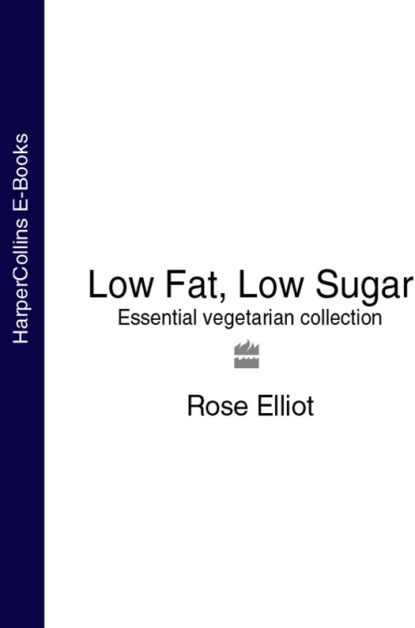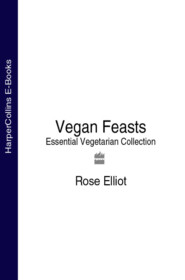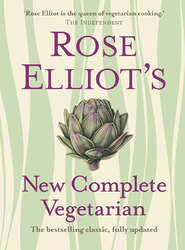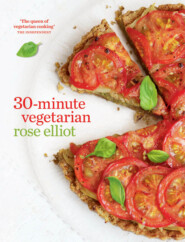По всем вопросам обращайтесь на: info@litportal.ru
(©) 2003-2024.
✖
Low Fat, Low Sugar: Essential vegetarian collection
Настройки чтения
Размер шрифта
Высота строк
Поля
HOW LOW CAN YOU GO?
A completely fat-free diet would be unhealthy. Our bodies need to take in 4–6 per cent of calories as fat in order to be able to synthesise the essential fatty acids necessary for health. If you kept strictly to the Pritikin diet, Dr Dean Ornish’s diet or indeed the recipes given in this book, you would be getting about 10 per cent of your calories from fat; this being derived from the small amounts naturally present in whole grains, pulses, fruits, vegetables and low-fat dairy produce. The good news is that although these ingredients are low in fat, they contribute the vital nutrients which your body needs to heal itself and to function at its peak.
There are some practitioners who advocate supplementing our general diet with Essential Fatty Acids (EFA’s) either in the form of oil or capsules. A diet which is very low in fat allows you the leeway to include these valuable oils if you wish. They could be particularly beneficial to vegetarians, who are not getting any of the omega-oils from fish. Look for ‘Udo’s oils’ in health food stores, or ask the staff for advice. These oils need to be kept in the refrigerator and used up quickly.
CURING CANDIDIASIS
The recipes in this book are, like those of Dr Pritikin and Dr Ornish, based on the ingredients mentioned above. However, because I wanted this book to be useful for those suffering from yeast-related problems – the effects of an overgrowth of Candida albicans (candiasis) – I have also excluded other ingredients. There are no fruits or artificial sweeteners in the recipes; also excluded are yeast and products containing it; vinegar and fermented products, including soy sauce; malted products; anything containing mould, such as cheese; and mushrooms. Milk and most products made from it are also unsuitable because they contain lactic acid, which is a form of sugar. The exception is yogurt, which is allowed because most of the lactose has been digested by the bacteria present in the yogurt. So low-fat yogurt is suitable, even though other milk products are not.
Stimulants – tea, coffee, chocolate and cola drinks – also have to go because they cause the adrenal glands to trigger the release of the body’s sugar stores into the bloodstream, ‘feeding’ the candida in the same way as sugar in the digestive system. Caffeine is also banned from the Pritikin program, and by Dr Ornish. If you go to a nutritional therapist the first thing they will do, most likely, is tell you to give up coffee (and some will ban tea, too). Although it’s the caffeine which is the main problem, many practitioners recommend you avoid both normal and de-caffeinated coffee.
Having loved both tea and coffee, particularly the latter, dark and strong as could be, I could never imagine myself not drinking them. However, I have now given them up and I would not have believed how much better I feel. I mainly drink rooibosh tea, made from the seed of the redbush tree, in place of both tea and coffee. It has a flavour not unlike tea and although it took me a while to like it as much as I used to like tea, I can now say that I do. (But not as much as real coffee. My body likes it a lot better, though.) If you do come off tea and coffee, be prepared for some withdrawal symptoms – probably headaches – in the first few days. Take painkillers for these if you need to, but make sure that these do not contain caffeine.
If you suspect that you may be suffering from candida, symptoms of which range from chronic fatigue to aching joints and muscles and a weakened immune system, you can cure yourself by keeping to a strict diet and taking vitamin and anti-fungal supplements. I recommend Erica White’s Beat Candida Cookbook published by Thorsons for more information on this subject.
a personal note
When I write a cookery book I generally put on a pound or two in weight – an inevitable side-effect of all the tasting and testing which has to be done. It’s irritating, and a nuisance having to lose the weight afterwards; in fact it’s the one aspect of recipe writing that I don’t enjoy. During the writing of this book, however, it was different. When I’d finished I found that not only had I not gained the usual weight but I’d actually lost over half a stone without thinking about it or trying. The food was delicious and I had lots of energy. I hope it’s the same for you.
low-fat, low-sugar ingredients
After all my comments about foods which are not used in this book you’re probably wondering what on earth you can eat. Actually it’s surprising how many ingredients are suitable:
Fresh vegetables: all kinds can be eaten – raw or cooked, in soups, salads, main courses and, in the case of some of the sweeter ones such as butternut squash, as the basis for desserts and cakes. Choose organic if possible to avoid the risk of chemical residues. If you can’t manage to go completely organic, do choose organic carrots, lettuces and soya (also bananas, strawberries, milk and chocolate if you’re eating these). I’d also like to add organic potatoes to that list and hope that it won’t be very long before organic produce is the norm rather than the exception in all our food shops.
Frozen and canned vegetables: some of these are useful but make sure that they do not contain added sugar. Look for organic tomatoes canned without citric acid, particularly if you’re on the diet to combat candida. Canned sweetcorn without added sugar or salt is useful; also frozen sweetcorn, peas and broad beans.
Lemons: the only fruit permitted, apart from a little lime rind and juice which I’ve used very occasionally. Lemon juice is used instead of vinegar in dressings and a squeeze at the end of cooking is a useful flavour-enhancer in many dishes. Buy unwaxed, preferably organic lemons, especially if you’re going to use the skins as well as the juice.
Pulses: dried beans and lentils are wonderful, virtually fat-free sources of protein, fibre, minerals and vitamins. Many recipes in this book include these in either their dried or canned form. Again, buy organic if you can. Canned organic pulses are now available from large supermarkets and health food stores and are very handy, though dried pulses are easy to prepare.
To prepare pulses, cover with cold water and soak for 8 hours, or bring to the boil and leave to soak for 1 hour. Rinse and cover generously with fresh cold water. Boil rapidly for 10 minutes before reducing the heat and letting them boil gently until tender: usually 1–1
/
hours. Lentils and split peas cook in 20–60 minutes, depending on the type – they don’t need soaking before cooking although if you do soak them they cook more quickly. All pulses freeze well. For convenience, cook a 500g/18oz bag, divide into 5 portions and freeze – each portion will be the equivalent of a 425g/15oz can of beans.
Whole grains: this group includes brown rice, quinoa, millet and flaked brown rice, as well as brown rice flour and polenta (maize flour). Couscous is a refined, not a whole grain; bulgur wheat is a more nutritious alternative and is just as easy to prepare. Wholewheat pasta is also very useful in the diet. If you can’t eat wheat, non-wheat pastas made from vegetables, corn, millet and rice are available from health food stores.
Tofu: this useful and nutritious ingredient is used in quite a few of the recipes. It’s particularly important to buy an organic type to ensure that it hasn’t been made from GM soya beans.
Low-fat plain organic yogurt: If you can’t tolerate any dairy produce, use an unsweetened soya yogurt instead. You can buy this from health food stores, or it’s easy to make your own (see page (#litres_trial_promo)).
Soya milk: unsweetened organic soya milk is used in recipes instead of dairy milk.
Organic free-range eggs: egg whites are used in a few of the recipes in this book.
Cold-pressed organic olive oil: this is used only in a handful of the recipes. If you wish to add a light misting of oil to vegetables before roasting or frying, you might like to make an oil spray by putting some olive oil into a spray bottle, topping up with 8 parts of cold water and shaking and spraying when required.
Spices: apart from the very hot spices, such as chilli and cayenne, these are usually allowed and are invaluable for making low-fat, low-sugar meals taste really good. A particular favourite in this book is cumin, in both seed and powdered form; ground coriander and turmeric are also invaluable, as is nutmeg – buy it whole and grate as required. Freshly ground black pepper can also be used freely. Buy the spices as you need them for a particular recipe and you’ll soon build up a useful collection.
Fresh herbs: I think the availability of a wide range of fresh herbs is one of the factors that has made the most impact on our cooking in the last ten years. They are a wonderful way of adding freshness and flavour to dishes and make a very appetising garnish. Fresh ginger and garlic are also indispensable flavourings.
Salt: may not be recommended by most health experts, but it is difficult to reduce while still retaining flavour. As a substitute, I have recently been using a sodium-reduced sea salt from Iceland. It is the best of the reduced sodium salts that I have tried. Reduced sodium salts contain a higher percentage of potassium than normal salt, so if you’re having treatment for a kidney or heart disorder, check with your doctor before using it.
equipment and techniques
The only special equipment needed for low-fat, low-sugar cooking is one or two non-stick pans: ideally, a large non-stick frying pan with a lid and a medium-sized saucepan for making sauces and other mixtures that tend to stick. A non-stick baking sheet or tray is also useful or, alternatively, you could buy some of the non-stick fabric which you simply place on an ordinary baking tray. It can be washed and re-used time and again.
DRY-FRYING
The recipes in this book are fairly simple and do not involve complicated techniques. However, what I call ‘dry-frying’ is used in quite a number of the dishes. This is simply cooking in a frying pan or saucepan (non-stick) without added oil or liquid. By dry-frying an onion, for instance, you can get a result very much like fried onion. Put a fairly finely chopped onion into the frying pan, cover with a lid and set over a gentle heat. Let it cook for 6–7 minutes, stirring often. It will soften and become lightly flecked with brown. Turn up the heat if you want to brown it more, but take care because it’s easy to burn it and get a bitter flavour. If this seems likely, add a little water or stock and continue to gently ‘fry’ the onion until the liquid has disappeared and the onion is tender.
You can use this technique with any vegetable if you want a fried effect without using fat. If using no fat seems too extreme, you could try using just a teaspoonful of olive oil. It’s surprising how little you need. When I started experimenting with recipes for this book I initially used a teaspoonful of oil for the frying process, but having tried frying onions without any oil, decided to opt for this ‘purer’ approach which seemed to give results which were just as good. Once you start using little bits of oil here and little bits there, it starts to add up and the diet stops being ‘low fat’. However, how low you go is up to you; because the recipes are strict you have the scope to add a little fat here and there where it matters to you. One tablespoonful of oil adds 15 grams of fat to a recipe; a teaspoonful adds 5 grams of fat.
THE OIL AND WATER SPRAY
I think the idea for this originally came from low-fat cook extraordinaire Sue Kreitzman. All you do is buy a small spray bottle at a chemist or garden centre, fill this with olive oil and water in the proportion of 1 part oil to 8 or 10 parts water, shake well, then spray over your food. I use this on Mediterranean vegetables such as aubergines (eggplants) and courgettes (zucchini), or on burgers and rissoles before grilling or baking them. An alternative would be to use one of the oil sprays which you can buy in supermarkets, but making your own is so easy and you know exactly what’s in it. The only time when a supermarket oil spray is useful is for greasing cake tins (pans), although if you use non-stick baking parchment you don’t need it.
soups (#ulink_f5376e84-3cd5-5e61-b3fa-6eb56f9628d8)
When making a soup I generally start by sautéing an onion and any other vegetables in a tablespoonful of olive oil or a small amount of butter, as I have found that this gives the soup a superior flavour. However, wanting to keep the recipes as ‘pure’ as possible, I also experimented with dry-frying the onion and other vegetables before adding the stock or water and found that this also worked well. This process seems to draw out the flavour and, if you allow the vegetables to brown, caramelises their natural sugars and adds to the finished taste of the soup. So after much testing and experimenting, I decided to use this method as a basis for many of the soups. However, if you want to add a little fat, sautéing in 1 teaspoon of olive oil will usually add only about 1 gram of fat per serving.
Good stock can also contribute enormously to the success of a soup and is not difficult to come by now that you can buy vegetable stock in supermarkets or make up your own from good quality stock cubes or – my favourite – vegetable bouillon powder.
Of course in low-fat cookery you can’t rely on a splash of cream to add the final touch to soup and a spoonful of low-fat yogurt somehow doesn’t have the same effect. I think that often the nicest finishing touch is a generous scattering of chopped fresh herbs, which are easy to get almost anywhere all the year round.
flageolet bean, leek and watercress soup (#ulink_8ad54f07-c82d-5aee-87b4-d4b844a02ff5)
Pale green flageolet beans give this soup a delicate flavour, plentiful nutrients and a slightly thickened texture. You can buy them in cans at large supermarkets.
serves 4
2 leeks, sliced
425g/15oz can flageolet beans
600ml/20fl oz/2
/
cups vegetable stock or water
1 bunch or packet of watercress
salt and freshly ground black pepper
Put the leek into a non-stick pan, cover and cook very gently for about 7 minutes, until the leek is becoming tender, stirring from time to time. Drain and rinse the beans, then add them to the pan along with the stock or water. Bring to the boil, then reduce the heat, cover and leave to boil gently for 10–15 minutes, stirring occasionally, until the leeks are fully cooked. Put a ladleful of the soup into a food processor or blender with the watercress and whiz to a purée. Return this to the saucepan, stir and season with salt and freshly ground black pepper. Bring back to just below boiling point and serve.









